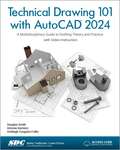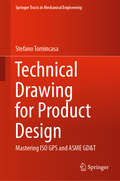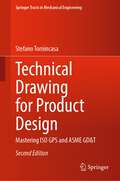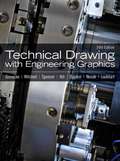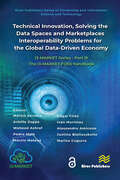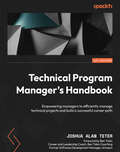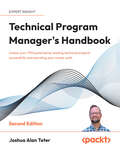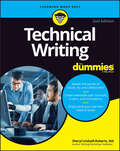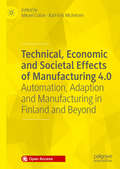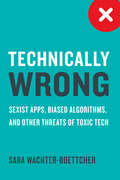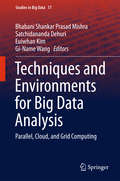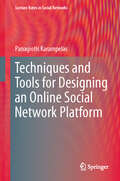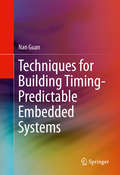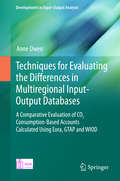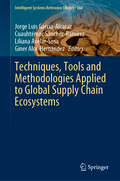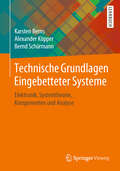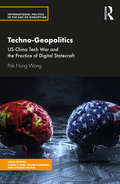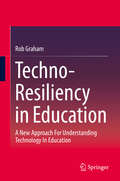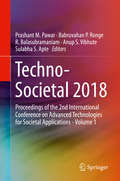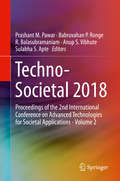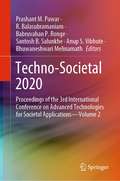- Table View
- List View
Technical Drawing 101 with AutoCAD 2024: A Multidisciplinary Guide to Drafting Theory and Practice with Video Instruction
by Douglas Smith Ashleigh Congdon-Fuller Antonio RamirezTechnical Drawing 101 covers topics ranging from the most basic, such as making freehand, multiview sketches of machine parts, to the advanced―creating an AutoCAD dimension style containing the style settings defined by the ASME Y14.5-2009 Dimensioning and Tolerancing standard. But unlike the massive technical drawing reference texts on the market, Technical Drawing 101 aims to present just the right mix of information and projects that can be reasonably covered by faculty, and assimilated by students, in one semester. Both mechanical and architectural projects are introduced to capture the interest of more students and to offer a broader appeal.
Technical Drawing for Product Design: Mastering ISO GPS and ASME GD&T (Springer Tracts in Mechanical Engineering)
by Stefano TornincasaThis book is intended for students, academics, designers, process engineers and CMM operators, and presents the ISO GPS and the ASME GD&T rules and concepts. The Geometric Product Specification (GPS) and Geometrical Dimensioning and Tolerancing (GD&T) languages are in fact the most powerful tools available to link the perfect geometrical world of models and drawings to the imperfect world of manufactured parts and assemblies. The topics include a complete description of all the ISO GPS terminology, datum systems, MMR and LMR requirements, inspection, and gauging principles. Moreover, the differences between ISO GPS and the American ASME Y14.5 standards are shown as a guide and reference to help in the interpretation of drawings of the most common dimensioning and tolerancing specifications.The book may be used for engineering courses and for professional grade programmes, and it has been designed to cover the fundamental geometric tolerancing applications as well as the more advanced ones. Academics and professionals alike will find it to be an excellent teaching and research tool, as well as an easy-to-use guide.
Technical Drawing for Product Design: Mastering ISO GPS and ASME GD&T (Springer Tracts in Mechanical Engineering)
by Stefano TornincasaThis book is intended for students, academics, designers, process engineers and CMM operators, and presents the ISO GPS and the ASME GD&T rules and concepts. The Geometric Product Specification (GPS) and Geometrical Dimensioning and Tolerancing (GD&T) languages are in fact the most powerful tools available to link the perfect geometrical world of models and drawings to the imperfect world of manufactured parts and assemblies. The topics include a complete description of all the ISO GPS terminology, datum systems, MMR and LMR requirements, inspection, and gauging principles. Moreover, the differences between ISO GPS and the American ASME Y14.5 standards are shown as a guide and reference to help in the interpretation of drawings of the most common dimensioning and tolerancing specifications. The book may be used for engineering courses and for professional grade programmes, and it has been designed to cover the fundamental geometric tolerancing applications as well as the more advanced ones. Academics and professionals alike will find it to be an excellent teaching and research tool, as well as an easy-to-use guide. This 2nd, revised edition includes several improved features: - It highlights the tools provided in the recently published ISO GPS standards, such as ISO 22081-2021 and ISO 2692-2021. - New concepts and rules in accordance with the latest revision to the GD&T standard, ASME Y14.5.1-2019, Mathematical Definition of Dimensioning and Tolerancing Principles. - Most of the drawings have been redrawn and updated even further to the new standards. - Changes have been made to the text and illustrations to improve readability and clarify the content Additional contents and examples have been included. - The chapters dedicated to profile tolerance and tolerances (ISO 14405) have been extended and rewritten.
Technical Drawing with Engineering Graphics (Fourteenth Edition)
by Henry Cecil Spencer John Thomas Dygdon James E. Novak Frederick E. Giesecke Alva Mitchell Ivan Leroy Hill Shawna LockhartThe fourteenth edition of Giesecke's Technical Drawing with Engineering Graphics is a comprehensive introduction and detailed reference for creating 2D documentation drawings. Expanding on its reputation as a trusted reference for drawing technique, this edition continues to provide excellent integration of illustrations within the text and consistent navigational features that make it easier to refer to important information. This edition illustrates the application of technical drawing skills to real-world work practice, integrates drawing skills with CAD use in a variety of disciplines, and is updated with the most current ASME standards.
Technical Innovation, solving the Data Spaces and Marketplaces Interoperability Problems for the Global Data-Driven Economy: i3-MARKET Series - Part III: The i3-MARKET FOSS Handbook (River Publishers Series in Computing and Information Science and Technology)
by Martín Serrano Achille Zappa Waheed Ashraf Pedro Maló Márcio Mateus Edgar Fries Iván Martínez Alessandro Amicone Justina Bieliauskaite Marina CugurraIn the third i3-MARKET series book we focus on the best practices and simplest software methods and mechanisms that allow the i3-MARKET backplane reference implementation to be instantiated, tested and validated even before the technical expert and developer communities decide to integrate the i3-MARKET as a reference implementation or adopted open-source software tools. The purpose of this book is to offer a clear understanding of the technological components as well as the software infrastructures, and the steps to be followed to avoid overwhelming the deployment activity.i3-MARKET has three industrial pilots defined in terms of data resources used to deploy data-driven applications that use the most of the i3-MARKET backplane services and functionalities. The different software technologies developed, including the use of open-source frameworks, within the context of the i3-MARKET is considered as a bill of software artefacts of the resources needed to perform demonstrators, proof of concepts, and prototype solutions. The i3-MARKET handbook can be used as input for configurators and developers to set up and pre-test testbeds and therefore it is extremely valuable to organizations if used properly.
Technical Program Manager's Handbook: Empowering managers to efficiently manage technical projects and build a successful career path
by Joshua Alan Teter Ben TobinExplore the different aspects of the technical program manager's role in the tech world and get ready to advance your career across the Big Five tech companiesKey FeaturesUncover the secret to becoming a successful technical program managerLearn some of the system design principles and architectural concepts necessary for a TPMGet up and running with a wide range of foundational program management topicsBook DescriptionThe technical program manager (TPM) is a relatively new role born out of the need of the tech industry to have a specialized practitioner who speaks both tech and business and leverages this bilingual talent to get results that no one else can.This book dives into what makes a TPM tick. You'll find out which project and program management skills will help you shine and how you can apply your technical skills for effective results. This book looks at the TPM role across the Big Five tech companies (Amazon, Google, Microsoft, Apple, and Meta) to help you discern the most effective skills to be successful no matter which company you work for.Are you already a well-performing TPM looking to see what's next? This book identifies the career paths for a TPM at the Big Five to help you decide the next step for you.By the end of this book, you'll have a clear understanding of how to be a TPM, along with a breakdown of the necessary technical and program management skills to develop a clear roadmap for your career.What you will learnInvestigate why a TPM is an important role in the tech industryUnderstand the purpose and uniqueness of the TPM roleDiscover what makes a successful TPMNavigate project management with your unique technical skillsExplorer the career opportunities available for a TPMCompare the TPM role and responsibilities across the Big Five tech leadersWho this book is forThis TPM book is for aspiring and established technical program managers in the tech industry. To get the most out of this book, you should have a basic understanding of the project management life cycle and be comfortable with technical concepts as we dive into basic system design and architecture landscapes in context to the TPM role and expectations.
Technical Program Manager's Handbook: Empowering managers to efficiently manage technical projects and build a successful career path
by Joshua Alan TeterExplore the different aspects of the technical program manager's role in the tech world and get ready to advance your career across the Big Five tech companiesKey FeaturesUncover the secret to becoming a successful technical program managerLearn some of the system design principles and architectural concepts necessary for a TPMGet up and running with a wide range of foundational program management topicsBook DescriptionThe technical program manager (TPM) is a relatively new role born out of the need of the tech industry to have a specialized practitioner who speaks both tech and business and leverages this bilingual talent to get results that no one else can. This book dives into what makes a TPM tick. You’ll find out which project and program management skills will help you shine and how you can apply your technical skills for effective results. This book looks at the TPM role across the Big Five tech companies (Amazon, Google, Microsoft, Apple, and Meta) to help you discern the most effective skills to be successful no matter which company you work for. Are you already a well-performing TPM looking to see what’s next? This book identifies the career paths for a TPM at the Big Five to help you decide the next step for you. By the end of this book, you’ll have a clear understanding of how to be a TPM, along with a breakdown of the necessary technical and program management skills to develop a clear roadmap for your career.What you will learnInvestigate why a TPM is an important role in the tech industryUnderstand the purpose and uniqueness of the TPM roleDiscover what makes a successful TPMNavigate project management with your unique technical skillsExplorer the career opportunities available for a TPMCompare the TPM role and responsibilities across the Big Five tech leadersWho this book is forThis TPM book is for aspiring and established technical program managers in the tech industry. To get the most out of this book, you should have a basic understanding of the project management life cycle and be comfortable with technical concepts as we dive into basic system design and architecture landscapes in context to the TPM role and expectations.
Technical Program Manager's Handbook: Unlock your TPM potential by leading technical projects successfully and elevating your career path
by Joshua Alan TeterExplore the TPM role in depth with this revised second edition. New coverage includes advanced program management techniques, emotional intelligence, and AI integration. Join business with technology and elevate your career.Key FeaturesLearn advanced system design principles and architectural concepts necessary for a TPMGet up to speed with AI-driven project planning, risk management, and stakeholder communication toolsBenefit from practical tools, methodologies, case studies, and real-world examplesBook DescriptionThe role of the Technical Program Manager (TPM) is crucial in the tech industry, bridging the gap between technical expertise and business acumen. The second edition of the Technical Program Manager’s Handbook offers a comprehensive guide to excelling in this role. Building on the foundational concepts from the first edition, this updated version introduces new chapters that explore the integration of AI and Emotional Intelligence (EI) in program management. These crucial additions complement the broader focus of the book on bridging business and technology but don’t overshadow it. You'll learn how to apply AI-driven tools to enhance project planning, risk management, and stakeholder communication, as well as how to leverage EI to build strong team relationships and improve leadership effectiveness. This book provides practical tools, methodologies, and case studies, offering insights from industry leaders to help both aspiring and practicing TPMs apply advanced concepts and strategies effectively. It also explores the unique aspects of the TPM role in major tech companies, helping you to navigate and thrive in your career. By the end of this book, you'll have a clear understanding of the TPM role, along with a breakdown of the necessary technical and program management skills, to develop a clear roadmap for your career.What you will learnUncover the critical importance of the TPM role in the tech industryUnderstand and leverage the unique aspects of the TPM roleDiscover what makes a successful TPM through real-world case studiesMaster project management with advanced technical skills and AI toolsApply EI to enhance leadership and team managementExplore careers and paths for TPMs in the Big Five tech companiesWho this book is forThis book is designed for aspiring and established Technical Program Managers (TPMs), tech professionals transitioning into TPM roles, and recent graduates embarking on careers in technology consulting. It's also valuable for business analysts, project managers, and anyone supporting or working alongside TPMs. To fully benefit from this book, readers should have a basic understanding of the project management life cycle and be comfortable with technical concepts, as it dives into advanced topics and real-world applications.
Technical Writing For Dummies
by Sheryl Lindsell-RobertsLearn to document the technology that makes the world go Technical Writing For Dummies is a master class on how to build a career writing user manuals, e-learning, streaming, simulations, and more. It even zooms into the metaverse. Whether you’re new to the field, a seasoned professional, or a technical person who needs to write, this guide arms you with the skills you need to cash in on this flourishing world of technical writing. This isn’t your average how-to. It’s a compendium of innovative industry knowledge that will help you set yourself apart with the latest trends and best practices in technical writing. As a tech writer, you’ll need a robust skillset that allows you to offer clear and concise documentation for just about anything. This new edition of Technical Writing For Dummies—updated for all of today’s tech writing advances—can get you there. Uncover the basics of technical writing and master common documentation types Get insight into the career paths available to tech writers today Discover new remote collaboration options and cloud-based tools for technical writers Learn how to elevate your documents for high search engine optimization (SEO) rankings Improve your craft to connect with diverse, global audiencesWhether you’re a technical writer or technical professional who needs to write—you can learn the best practices of effective technical writing, as well as how to navigate its various formats and platforms, thanks to this handy Dummies guide.
Technical Writing for Software Developers: Enhance communication, improve collaboration, and leverage AI tools for software development
by Chris ChinchillaElevate your software development process with expert technical writing skills, fostering clarity, collaboration, and successful product outcomesKey FeaturesOptimize documentation workflows with collaborative version-controlled "docs-as-code" tooling optionsEngage with interactive learning modules embedded throughout the bookImprove software quality as a lead developer through effective communication in documentationPurchase of the print or Kindle book includes a free PDF eBookBook DescriptionEffective documentation is key to the success of products in remote software development teams, facilitating clear instructions that benefit the entire development team. Technical Writing for Software Developers lays a solid foundation of essential grammar, providing language tips and explaining how precise writing enhances documentation, and walks you through the fundamental types and styles of documentation. Starting with an exploration of the current state of the tech writing industry and its significance in both the software and hardware realms, you’ll master the building blocks of technical writing, exploring tooling choices and style guides, and create dynamic multimedia-laden documentation. This book equips you with valuable insights into the writing and feedback process to ensure continuous improvement. Additionally, you’ll take a peek at the emerging trends and technologies, including AI tools, shaping the future of technical writing. By the end of this technical writing book, you’ll have developed the expertise you need to tackle documentation requests effectively, armed with the knowledge of the best approach for documenting any topic, encompassing text, media elements, structure, and appropriate tools. The skills acquired will enable you to achieve seamless teamwork, enhanced project efficiency, and successful software development.What you will learnCreate engaging multimedia-rich documentationUnderstand the types and styles of documentationDiscover grammar and language tips for clear communicationStreamline your documentation process with the right tooling choiceMaster the writing and feedback process for continuous improvementExplore automation techniques for efficient documentation workflowsEmbrace AI-powered tools for enhanced technical writingWho this book is forThis book is for software developers who want to improve their technical writing prowess. Whether you are a junior developer looking to refine your documentation skills or a professional striving for smoother collaboration, this resource equips you with all the essential knowledge and practical insights you need. Covering everything from creating clear documentation to enhancing career prospects, this book caters to a diverse range of software developers, including programmers, software architects, and software engineers looking to streamline the product development process and save time.
Technical, Economic and Societal Effects of Manufacturing 4.0: Automation, Adaption and Manufacturing in Finland and Beyond
by Mikael Collan Karl-Erik MichelsenThis open access book is among the first cross-disciplinary works about Manufacturing 4.0. It includes chapters about the technical, the economic, and the social aspects of this important phenomenon. Together the material presented allows the reader to develop a holistic picture of where the manufacturing industry and the parts of the society that depend on it may be going in the future. Manufacturing 4.0 is not only a technical change, nor is it a purely technically driven change, but it is a societal change that has the potential to disrupt the way societies are constructed both in the positive and in the negative.This book will be of interest to scholars researching manufacturing, technological innovation, innovation management and industry 4.0.
Technically Wrong: Why Digital Products Are Designed To Fail You
by Sara Wachter-BoettcherA revealing look at how tech industry bias and blind spots get baked into digital products—and harm us all. Buying groceries, tracking our health, finding a date: whatever we want to do, odds are that we can now do it online. But few of us ask why all these digital products are designed the way they are. It’s time we change that. Many of the services we rely on are full of oversights, biases, and downright ethical nightmares: Chatbots that harass women. Signup forms that fail anyone who’s not straight. Social media sites that send peppy messages about dead relatives. Algorithms that put more black people behind bars. Sara Wachter-Boettcher takes an unflinching look at the values, processes, and assumptions that lead to these and other problems. Technically Wrong demystifies the tech industry, leaving those of us on the other side of the screen better prepared to make informed choices about the services we use—and demand more from the companies behind them.
Technics Improvised: Activating Touch in Global Media Art
by Timothy MurraySeeing new media art as an entry point for better understanding of technology and worldmaking futures In this challenging work, a leading authority on new media art examines that curatorial and aesthetic landscape to explore how art resists and rewires the political and economic structures that govern technology. How do inventive combinations of artistic and theoretical improvisation counter the extent to which media art remains at risk, not just from the quarantines of a global pandemic but also from the very viral and material conditions of technology? How does global media art speak back to the corporate closures of digital euphoria as clothed in strategies of digital surveillance, ecological deprivation, and planned obsolescence? In Technics Improvised, Timothy Murray asks these questions and more. At the intersection of global media art, curatorial practice, tactical media, and philosophy, Murray reads a wide range of creative performances and critical texts that envelop artistic and digital materials in unstable, political relations of touch, body, archive, exhibition, and technology. From video to net art and interactive performance, he considers both canonical and unheralded examples of activist technics that disturb the hegemony of biopolitical/digital networks by staging the very touch of the unsettling discourse erupting from within. In the process, critical dialogues emerge between a wide range of artists and theorists, from Hito Steyerl, Ricardo Dominguez, Joan Jonas, Isaac Julien, Ryoji Ikeda, and Shadi Nazarian to Gilles Deleuze, Jean-Luc Nancy, Elizabeth Povinelli, Jean-François Lyotard, Erin Manning, Achille Mbembe, and Samuel Weber.Brilliantly conceived and argued and eloquently written, Technics Improvised points the way to how artistic and theoretical practice can seize on the improvisational accidents of technics to activate creativity, thought, and politics anew.
Techniques and Environments for Big Data Analysis
by Bhabani Shankar Prasad Mishra Satchidananda Dehuri Euiwhan Kim Gi-Name WangThis volume is aiming at a wide range of readers andresearchers in the area of Big Data by presenting the recent advances in the fieldsof Big Data Analysis, as well as the techniques and tools used to analyze it. The book includes 10 distinct chaptersproviding a concise introduction to Big Data Analysis and recent Techniques and Environments forBig Data Analysis. It gives insightinto how the expensive fitness evaluation of evolutionarylearning can play a vital role in big data analysis by adopting Parallel, Grid, and Cloud computing environments.
Techniques and Tools for Designing an Online Social Network Platform
by Panagiotis KarampelasFollowing the introduction of Myspace, Linkedin and Facebook, social networks have become part of people's everyday life. New online social networks appear almost daily developed to attract the attention of Internet users. However, design and implementation standards and guidelines are often sacrificed for innovation resulting in unusable social networking platforms destined to be doomed. Within this context, the present book recommends a design and implementation methodology which will allow future social networking platform designers and developers to work in a scientifically systematic and sound manner to reach their goal. The journey begins with the identification of the pursued objective of the social network and the potential participants. The presentation of various methods and techniques to collect the requirements of the intended user group of the social networking platform follows. Best practices, guidelines and standards that will facilitate the conceptual and physical design of the platform are portrayed. An analysis of advantages and limitations for existing implementation platforms and potential implementation techniques is subsequently offered to facilitate the selection of the most appropriate tool for the implementation of the online social networking website. Various representative visualization techniques are examined in order to enhance the visual representation of the social network participants. Various usability evaluation techniques are then presented to aid in the assessment of usability and improvement of the actual user experience. Finally, future trends in the design and use of social networks are presented.
Techniques for Building Timing-Predictable Embedded Systems
by Nan GuanThis book describes state-of-the-art techniques for designing real-time computer systems. The author shows how to estimate precisely the effect of cache architecture on the execution time of a program, how to dispatch workload on multicore processors to optimize resources, while meeting deadline constraints, and how to use closed-form mathematical approaches to characterize highly variable workloads and their interaction in a networked environment. Readers will learn how to deal with unpredictable timing behaviors of computer systems on different levels of system granularity and abstraction.
Techniques for Evaluating the Differences in Multiregional Input-Output Databases
by Anne OwenThis book introduces the Eora, Global Trade Analysis Project (GTAP) and World Input-Output (WIOD) databases and provides detailed metadata on the data sources, database structures and construction techniques used to build each system. It offers a detailed account of how multi-regional input-output (MRIO) databases are used to calculate consumption-based accounts - guiding the reader through each mathematical step and explaining the associated equations. It demonstrates that different MRIO databases calculate different national level consumption-based CO2 accounts. If these results are to be used as evidence in climate policy-making, analysts need to be confident about the accuracy of the databases and understand why the results differ. It carefully explains the mathematical equations behind each technique and provides a link to a repository where the reader can access specially prepared MATLAB functions associated with the techniques. To make meaningful comparisons between the three MRIO databases, each is mapped to a consistent classification system comprising 40 countries and 17 sectors. Further, readers can access the aggregated databases using the link provided. The effect of this aggregation is shown to be minimal, so readers can be confident that the aggregated versions of each database reflect the full-sized versions. The book concludes by making recommendations as to how future MRIO databases could be accurately and consistently constructed and how they should be used in policy-making in light of the findings.
Techniques of Decision Making, Uncertain Reasoning and Regression Analysis Under the Hesitant Fuzzy Environment and Their Applications (Uncertainty and Operations Research)
by Zeshui Xu Chenyang SongThis book mainly introduces some techniques of decision-making, uncertain reasoning and regression analysis under the hesitant fuzzy environment and expands the applications of hesitant fuzzy sets in solving practical problems. The book pursues three major objectives: (1) to introduce some techniques about decision-making, uncertain reasoning and regression analysis under the hesitant fuzzy environment, (2) to prove these techniques theoretically and (3) to apply the involved techniques to practical problems. The book is especially valuable for readers to understand how hesitant fuzzy set could be employed in decision-making, uncertain reasoning and regression analysis and motivates researchers to expand more application fields of hesitant fuzzy set.
Techniques, Tools and Methodologies Applied to Global Supply Chain Ecosystems (Intelligent Systems Reference Library #166)
by Jorge Luis García-Alcaraz Giner Alor-Hernández Cuauhtémoc Sánchez-Ramírez Liliana Avelar-SosaThis book presents the latest developments concerning techniques, tools, and methodologies in supply chain ecosystems. It gathers contributions from a variety of experts, who analyze a range of case studies and industrial sectors such as manufacturing, energy, agricultural, healthcare, humanitarian logistics, and urban goods distribution, to name but a few. The book is chiefly intended to meet the needs of two sectors: firstly, the academic sector, so as to familiarize students, professors, and researchers with the tools that are now being used to optimize supply chains; and secondly, the industrial and managerial sector, so that supply chain management practitioners can benefit from methods and tools that are yielding valuable results in other contexts.
Technische Grundlagen Eingebetteter Systeme: Elektronik, Systemtheorie, Komponenten und Analyse
by Karsten Berns Alexander Köpper Bernd SchürmannLernen Sie mit diesem Lehrbuch eingebettete Systeme besser kennenEmbedded Systems (eingebettete Systeme) sind aus dem Alltag nicht mehr wegzudenken. In Smartphones, Fahrzeugen oder Haushaltsgeräten verbinden sie die analoge mit der digitalen Welt. Daraus ergeben sich speziell für Entwickler eingebetteter Systeme viele Anforderungen. Sie müssen nicht nur Kenntnisse aus der Entwicklung von Softwaresystemen mitbringen, sondern gleichzeitig Wissen in Sachen Elektrotechnik oder Systemkomponenten besitzen. Dieses Lehrbuch führt Sie umfassend in das Feld eingebetteter Systeme ein. Die Autoren liefern Ihnen das notwendige methodische sowie systematische Wissen zur Systementwicklung. Zum optimalen Verständnis ist dieses Werk in vier Teile untergliedert:Technische Grundlagen eingebetteter Systeme aus den Gebieten Elektronik, Systemtheorie, Steuerung und Regelung Systemtheoretische Grundlagen und Entwürfe von ReglernÜberblick und Einbindung der Systemkomponenten eingebetteter SystemeModellierung und Analyse von Algorithmen mit Blick auf EchtzeitanforderungenDurch Anwendungsbeispiele und Methoden der Echtzeitplanung können Sie mit diesem Lehrbuch Ihr Wissen im Bereich eingebettete Systeme nachhaltig vertiefen. Inhaltlich für Praktiker und Theoretiker zu empfehlenAufgrund seines thematischen Schwerpunkts profitieren von diesem Werk speziell folgende Leser:a) Studierende und Anwender der Informatik ohne tiefgreifende Vorkenntnisse im Bereich Elektrotechnikb) Ingenieure, Physiker und Mathematiker, die sich für die Grundlagen der Entwicklung eingebetteter Systeme interessierenIn den einführenden Kapiteln des Lehrbuchs definieren die Autoren zunächst die Merkmale eingebetteter Systeme. Sie zeigen Ihnen Anwendungsfelder und erläutern, in welcher Form diese Systeme zum Einsatz kommen – beispielsweise als Cyber-Physikalische Systeme (CPS). Im weiteren Verlauf werden u. a. diese Teilaspekte näher behandelt:Elektrische NetzwerkeElektronische GrundschaltungenSignalverarbeitungsprozesseSensordatenverarbeitungAktuatorikRecheneinheiten für eingebettete SystemeKommunikationEin Grundlagenwerk mit verständlichem KonzeptDurch seinen systematischen Aufbau ermöglicht Ihnen dieses Werk einen schnellen Einstieg in die Materie. Anschauliche Tabellen, Grafiken, Anwendungsbeispiele sowie Modelle unterstützen Sie beim Lernprozess. Wenn Sie sich für eingebettete Systeme interessieren, darf dieses Lehrbuch in Ihrer Sammlung nicht fehlen.
Techno-Geopolitics: US-China Tech War and the Practice of Digital Statecraft (International Politics in the Age of Disruption)
by Pak Nung WongTechno-Geopolitics explores contemporary US-China relations and the future of global cyber-security through the prisms of geopolitics and financial-technological competition. It puts forward a new conceptual framework for an emerging field of digital statecraft and discusses a range of key issues including the controversies around 5G technology, policy regulations over TikTok and WeChat, the emergence of non-traditional espionage, and potential trends in post-pandemic foreign policy. Analysing the ramifications of the ongoing US-China trade standoff, this book maps the terrain of technological war and the race for global technological leadership and economic supremacy. It shows how China’s technological advancements have not only been the key to its national economic development but have also been the core focus of US intelligence. Further, it draws on US-China counter-intelligence cases sourced from the US Department of Justice and Federal Bureau of Investigation (FBI) to explore emerging patterns and techniques of China’s espionage practice. A cutting-edge study on the future of statecraft, this volume will be of great interest to scholars and researchers of international relations, security and intelligence studies, information technology and artificial intelligence, political science, especially US foreign policy and China studies. It will also be of great interest to policymakers, career bureaucrats, security and intelligence practitioners, technology regulators, and professionals working with think tanks and embassies.
Techno-Resiliency in Education
by Rob GrahamThis book formulates a greater understanding of how to enable a capacity for building social professional practice related to technology-enriched teaching and learning (TETL) specific, but not limited to, educational settings. This book comes at a time when many in education are struggling to provide a technology enriched learning experience for students who are entering classrooms with high expectations for such an experience. The focus on the protective factors and identified resilient professional practices, instead of on well documented and commonly cited risk factors and barriers that impede the effective integration of TETL, represents a distinguishing feature of this work. By attempting to better understand and document how two schools that were classified as resilient in their use of technology have been able to overcome risk factors (e. g. , budgetary constraints, a lack of resources, a lack of training, technological support issues), this book will offer the unique concept of techno-resiliency and some of its deeper insights and strategies.
Techno-Societal 2018: Proceedings of the 2nd International Conference on Advanced Technologies for Societal Applications - Volume 1
by Prashant M. Pawar Babruvahan P. Ronge R. Balasubramaniam Anup S. Vibhute Sulabha S. ApteThis book, divided in two volumes, originates from Techno-Societal 2018: the 2nd International Conference on Advanced Technologies for Societal Applications, Maharashtra, India, that brings together faculty members of various engineering colleges to solve Indian regional relevant problems under the guidance of eminent researchers from various reputed organizations.The focus is on technologies that help develop and improve society, in particular on issues such as the betterment of differently abled people, environment impact, livelihood, rural employment, agriculture, healthcare, energy, transport, sanitation, water, education. This conference aims to help innovators to share their best practices or products developed to solve specific local problems which in turn may help the other researchers to take inspiration to solve problems in their region. On the other hand, technologies proposed by expert researchers may find applications in different regions. This offers a multidisciplinary platform for researchers from a broad range of disciplines of Science, Engineering and Technology for reporting innovations at different levels.
Techno-Societal 2018: Proceedings of the 2nd International Conference on Advanced Technologies for Societal Applications - Volume 2
by Prashant M. Pawar Babruvahan P. Ronge R. Balasubramaniam Anup S. Vibhute Sulabha S. ApteThis book, divided in two volumes, originates from Techno-Societal 2018: the 2nd International Conference on Advanced Technologies for Societal Applications, Maharashtra, India, that brings together faculty members of various engineering colleges to solve Indian regional relevant problems under the guidance of eminent researchers from various reputed organizations.The focus is on technologies that help develop and improve society, in particular on issues such as the betterment of differently abled people, environment impact, livelihood, rural employment, agriculture, healthcare, energy, transport, sanitation, water, education. This conference aims to help innovators to share their best practices or products developed to solve specific local problems which in turn may help the other researchers to take inspiration to solve problems in their region. On the other hand, technologies proposed by expert researchers may find applications in different regions. This offers a multidisciplinary platform for researchers from a broad range of disciplines of Science, Engineering and Technology for reporting innovations at different levels.
Techno-Societal 2020: Proceedings of the 3rd International Conference on Advanced Technologies for Societal Applications—Volume 2
by Prashant M. Pawar Babruvahan P. Ronge R. Balasubramaniam Anup S. Vibhute Santosh B. Salunkhe Bhuwaneshwari MelinamathThis book, divided in two volumes, originates from Techno-Societal 2020: the 3rd International Conference on Advanced Technologies for Societal Applications, Maharashtra, India, that brings together faculty members of various engineering colleges to solve Indian regional relevant problems under the guidance of eminent researchers from various reputed organizations.The focus of this volume is on technologies that help develop and improve society, in particular on issues such as advanced and sustainable technologies for manufacturing processes, environment, livelihood, rural employment, agriculture, energy, transport, sanitation, water, education. This conference aims to help innovators to share their best practices or products developed to solve specific local problems which in turn may help the other researchers to take inspiration to solve problems in their region. On the other hand, technologies proposed by expert researchers may find applications in different regions. This offers a multidisciplinary platform for researchers from a broad range of disciplines of Science, Engineering and Technology for reporting innovations at different levels.
